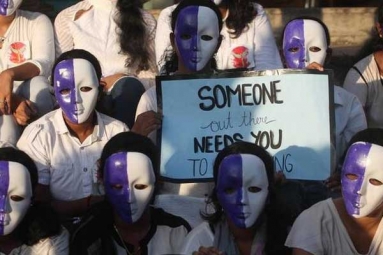
(Image source from: US News Health - US News & World Report)
Suicide is a major public health concern all across the world. Over 8,00,000 people commit suicide worldwide yearly and of these 1,35,000 are residents of India.
Suicide is complicated and tragic but is oftentimes preventable. Having a knowledge about the warning signs of suicide is vital to saving lives and rendering essential psychological and pharmacological help to people who are in distress.
Some common symptoms and signs of a person who is suicidal include the following:
(a) Talking over wanting to die or to kill oneself
(b) Long-standing feelings of emptiness and hopelessness
(c) Making a comprehensive suicide plan, such as probing online for ways and means to commit suicide. Some common suicide plans include stocking on pills or pesticides, in secret buying risky weapons, sharp instruments, knives, etc
(d) Feeling guilt or shame for no reason and talking about it
(e) Feeling cornered and as though there is no escape from suffering. Feeling that there are no solutions in sight
(f) Talking about being a burden to others and feeling intolerable emotional pain.
(g) Increased use of alcohol and other harmful substances to cope with feelings of anxiety, agitation
(h) Abrupt withdrawal from one's social circle
(i) Experiencing terrible mood swings
What drives a person to commit suicide?
Suicide is not partisan and in that it does not discriminate. It is a complex neuro-bio-psycho-sociological phenomenon and people of all ages and genders may be at peril. However, some common risk factors include:
(a) Having a diagnosis of depression or any other psychiatric disorder
(b) Chronic medical conditions such as cancer, AIDS (Acquired Immune Deficiency Syndrome), connective tissue disorders prior suicide attempt
(d) The family history of suicide, substance use disorder, mood disorder or any other psychiatric disorder
(e) Being a victim of child sexual abuse (CSA) or intimate partner violence (IPV)
(f) Having exposure to violent and suicidal behaviors of others through various media platforms, online content, and cinemas.
Suicidal therapies
There are a plethora of treatment options that exist for helping an individual who is suicidal. Broadly, three modalities exist for treating a patient who is suicidal.
Talk therapies
Psychotherapy is a psychosocial, non-pharmacological intervention and multiple studies have replicated the efficacy of psychotherapy in reducing the risk of suicide. The commonest form of ''talk therapy'' is Cognitive Behavioural Therapy (CBT). This enables individuals to identify their faulty thought patterns and the therapist then tries to modify or restructure them. This helps the individual to cope with stressful situations and to consider alternative actions when thoughts of suicide arise.
For people diagnosed with a personality disorder, such as borderline personality disorder, dialectical behavioral therapy (DBT) is used. The gist of DBT lies in enabling the client to tolerate his/ her distress and finding better coping strategies instead of indulging in harmful or unsafe behaviors.
Pharmacotherapy
According to multiple studies, when talk therapy is combined with medication, the efficaciousness of the treatment increases. Only psychiatrists are allowed to prescribe psychotropic drugs and it is critical that the client seeks professional aid as it can make a pronounced difference in one's quality of life. The selection of the drug depends on the underlying cause for suicide.
In schizophrenia, clozapine has shown enormous benefit in reducing suicide risk. For patients with bipolar disorder, Lithium acts as an effective anti-suicidal agent. Apart from these, various other medications such as anti-depressants and anxiolytics are utilized for reducing suicide risk. Contrary to what is believed, these agents are harmless, effective and do not cause long-term dependence. They are tapered and stopped after 6-9 months and are not sustained indefinitely.
Brain stimulation techniques
Modalities such as electroconvulsive therapy (ECT) and insistent trans-cranial magnetic stimulation are the most useful strategies in patients who are actively and chronically suicidal. These modalities are safe and are routinely used clinically. With the advances in safe anesthetic practices, ECT continues to be the gold standard in helping acutely suicidal patients. Unfortunately, it has been portrayed in a negative manner in the media and in movies.
Apart from these modalities, training public regarding suicide and building consciousness about mental health issues is essential.
Gatekeeper training involves training teachers, volunteers, health workers, community and social workers in identifying people who are at risk for suicide and then efficaciously directing them towards professional assist. Infinite lives are lost to this scourge called suicide.
It is the duty of every government to make mental health a priority so that many lives can be blessed.
By Sowmya Sangam









